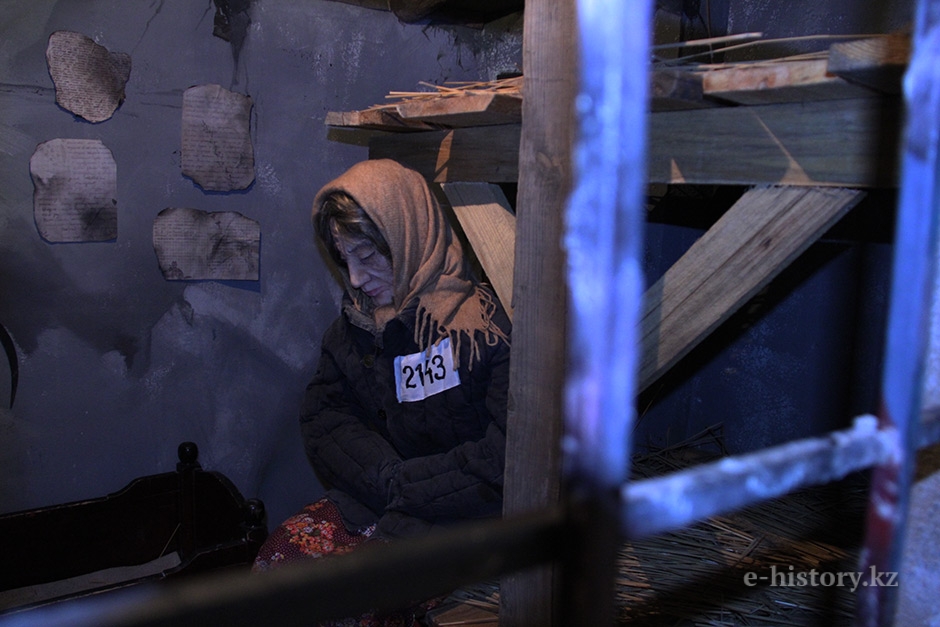“Only for us, my beloved, roads are already defined”. Prisoners of ALZHIR

28.05.2014
2334
«From now on we are flightless birds
A chick was blown away to the reeds…»
Behind the iron grille, in severe cold, heat and dust, under the gun muzzles of machine guards and dog’s howling in captivity worked women. Their eyes were doomed, lost and full of dumb question «Why?» Their thoughts were about home, children, with anxiety about what the future holds.
ALZHIR — Akmola camp for wives of traitors — the largest women’s camp in the Soviet Union in the era of totalitarianism. Committed no crime, women had to serve their sentence for as they were mothers, wives, sisters and daughters of those who were accused of treason.
Today in that place there is a museum and memorial complex ALZHIR. The memorial «Arch of Sorrow» is about to open. It symbolizes the meeting of two worlds — the living and the dead. Passing under the arch, you need to bow your head in respect. In bad weather, in the construction of arches can be heard sighs and wind noise like the voice of the time, the voice of history.
The main exhibition of the museum consists of two sections. The first section - the exposition "Alash", dedicated to the political history of Kazakhstan in 19th -20th centuries.
In the center of the hall there is a composition - "Flower of Life". Flower breaks through the stone, saying that, despite the many horrors and misfortunes, life goes on.
Rising up the head, you will see the composition «Freedom and slavery." The composition represents a snare, which includes 15 pigeons that beat their wings in hopes to soar.
The second section fully covers the history of Akmola camp for wives of traitors (ALZHIR). Exposure in large part consists of photographs, documents, memoirs, personal belongings of ALZHIR female prisoners and their children. Here presented following: the installation of «Hold» with a genuine door remand prison 30s, diorama «ALZHIR», tells the story of the everyday life of prisoners of camp, camp reconstruction fragments garment factory, office investigator and barracks.
On January 6, 1938 the first batch of women with children aged one to three years came to Akmola camp. The camp consisted of several adobe huts, four towers and barbed wire. Within two months prisoners continuously kept arriving. Women in ALZHIR brought from across the country: from Moscow, Leningrad, Ukraine, Belarus, Georgia, Armenia and Central Asia. Seats for women in prison were not enough. And the newcomers themselves built themselves huts in a snowstorm and blizzard, heat and rain, they set bunk. Instead of mattresses they throw straw on wooden decking.
Among women prisoners of ALZHIR were widely known in the Union singer Lidiya Ruslanova, actress Tatiana Okunevskaya and Natalia Sats, Rahilya Plisetskaya, famous writer Galina Serebryakova, wives of poets and writers, statesmen’s wife Aziza Ryskulova, Gulzhamal Mailina, Gulyandam Khodzhanova, Zufnun Nurmakova, Aish Kulumbetova, Fatima Diveyeva, Elizabeth Sadvokasova and others. Known or unknown — they all suffered innocently and deserve to be remembered about them.
Rahil Plisetskaya with kids
On a day of life ALZHIR gives a complete picture scale diorama museum. There are figures of female prisoners, armed escort, barking dogs, around the boundless steppe lakes and saucers and above all this blue sky Kazakhstan.
No sorrow in the world worse than mother’s grief that deprives their children. Almost all the «ALZHIR» women passed through it. Children were taken away from arrested women and sent to the nursery and orphanage Commissariat. Kids from 3 to 15 years to orphanages Narcompros and teenagers from 15 years were recognized the «socially dangerous» and subjected to repression or placed to special institutions. The museum presents photographs, children’s letters — poignant evidences of terrible years.
Children of ALZHIR
Letters of kids
We do not know the fault…
To repent was not a sin for us…
Yet our evil trouble
Someone will tell for everyone…
It took more than a decade since wooden barracks and convoy towers, enclosed by barbed wire, forever disappeared. The village has gained a new life and a new name Akmola that did not remind those terrible years. But «wives» are not forgotten here. Memory of the victims of the tragedy was preserved for descendants. For the descendants of those who had to go through all the horrors of prison and hell of camp stages.
Wall of Remembrance of Victims of Political Repression
Alena Demchenko